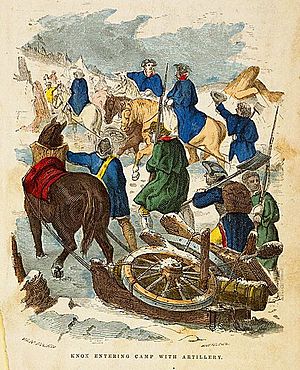Noble train of artillery facts for kids
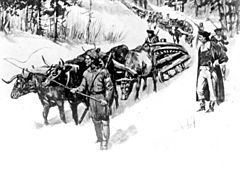
An ox team hauling Ticonderoga's guns
|
|
| Date | November 17, 1775 – January 25, 1776 (70 days) |
|---|---|
| Location | British provinces of New York and Massachusetts Bay |
| Participants | Colonel Henry Knox |
| Outcome | Fortification of Dorchester Heights |
The Noble Train of Artillery, also called the Knox Expedition, was an amazing journey during the American Revolutionary War. It was led by Colonel Henry Knox of the Continental Army. His mission was to move heavy cannons and other weapons. These weapons had been captured at Fort Ticonderoga. Knox had to transport them to the Continental Army camps near Boston. This happened during the cold winter of 1775–76.
Knox traveled to Ticonderoga in November 1775. Over three winter months, he moved about 60 tons of cannons and other arms. He used boats, horses, and sleds pulled by oxen. People also helped by pulling the heavy loads. They traveled along bad roads, crossed two partly frozen rivers, and went through forests and swamps. These areas were not very populated. The journey covered about 300 miles (480 km) to the Boston area. Historians call this feat "one of the most amazing achievements in moving supplies" of the entire American Revolutionary War. The path he followed is now known as the Henry Knox Trail. The states of New York and Massachusetts have put up markers along the way.
Contents
Why the Expedition Was Needed
The American Revolutionary War began with the Battles of Lexington and Concord in April 1775. After these battles, American forces surrounded the British in Boston. This was called the Siege of Boston. Benedict Arnold, a militia leader, suggested capturing Fort Ticonderoga. This fort was in New York on Lake Champlain. Arnold knew the fort had many heavy weapons. On May 3, he got permission to capture it.
Another group, the Green Mountain Boys, also wanted to capture Ticonderoga. They were led by Ethan Allen. Allen and Arnold joined forces. On May 10, their force of 83 men captured the fort without a fight. The next day, they captured nearby Fort Crown Point. Arnold started listing all the useful military equipment. But he faced problems with supplies and arguments over who was in charge. He eventually gave up on moving the weapons to Boston and left his position.
Planning the Big Trip
In July 1775, George Washington took command of the American forces outside Boston. He quickly saw a big problem: the new Continental Army did not have enough heavy weapons. This made it almost impossible to attack the British. It's not fully known who first suggested moving the Ticonderoga cannons. But historians often credit either Henry Knox or Benedict Arnold with the idea. No matter who suggested it, Washington chose Knox for the important job.
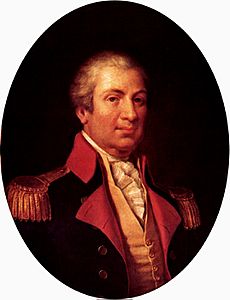
Knox was only 25 years old. He owned a bookstore and was very interested in military matters. He was a good friend of Washington's. When Washington gave him the task, he told Knox that "no trouble or expense must be spared to obtain them." On November 16, Washington ordered Knox to get the cannons. He also gave him £1000 for the trip. Washington also wrote to General Philip Schuyler, asking him to help Knox. The Second Continental Congress also wanted the weapons. They made Knox a colonel in November, but he didn't get the official paper until he returned from the expedition.
Knox left Washington's camp on November 17. He traveled to New York City to get supplies. He reached Ticonderoga on December 5. At Fort George, he shared a cabin with a young British prisoner named John André. André had been captured during the Siege of Fort St. Jean. He was on his way to a prison camp. Knox and André were similar in age and personality. They found many things to talk about. However, the next time they met, Knox was part of the court that decided André's fate for his role in Benedict Arnold's betrayal.
Moving the Cannons to Albany
When Knox arrived at Ticonderoga, he immediately started choosing the equipment. He also began organizing how to move it. He picked 59 pieces of equipment. These included cannons of different sizes, mortars, and howitzers. He estimated the total weight to be about 119,000 pounds (about 54 metric tons). The largest cannons weighed over 5,000 pounds (2,300 kg) and were 11 feet (3.4 m) long.
The equipment was first carried over land from Ticonderoga to the northern end of Lake George. Most of the cannons were loaded onto a flat-bottomed boat called a gundalow. On December 6, the gundalow sailed for the southern end of the lake. Knox sailed ahead in a smaller boat. Ice was already forming on the lake. The gundalow reached Sabbath Day Point, but it hit a submerged rock once. They sailed again the next day. Knox went ahead and reached Fort George quickly. But the gundalow did not arrive when expected. A boat went to check and reported that the gundalow had sunk not far from Sabbath Day Point. This seemed like a big problem. But Knox's brother William, who was captain of the gundalow, said that its sides were still above the water. They could bail out the water. They did this, and the boat floated again. The gundalow arrived at the southern end of the lake two days later.
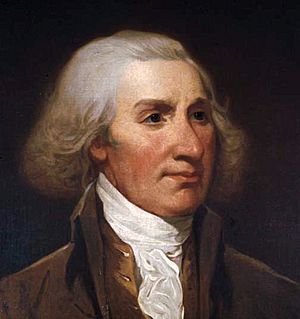
On December 17, 1775, Knox wrote to Washington. He said he had built "42 very strong sleds." He also had "80 yoke of oxen" to pull them as far as Springfield. He hoped to bring the "noble train of artillery" to Washington in 16 or 17 days. He then went ahead to Albany. He crossed the frozen Hudson River at Glens Falls. He continued through Saratoga and reached Lansingburg, New York, on Christmas Day. Two feet (61 cm) of snow fell that day. This slowed his progress because they had to clear a path through the snow. He finally reached Albany the next day, still slowed by the deep snow. There he met with General Philip Schuyler. They worked together to find equipment and people to help move the cannons south from Lake George. There was enough snow for sleds to move the cannons over land. But the river ice was still too thin to cross the Hudson River. Knox and his men tried to make the ice thicker by pouring more water on it. The first cannons arrived at Albany by January 4. Some cannons crashed through the ice into the river while crossing to Albany, and again when crossing the Hudson River towards Massachusetts. But each time, the cannons were recovered. By January 9, all the cannons had crossed the Hudson. Knox rode ahead to prepare for the next part of the journey.
Through the Berkshires
Details about the rest of the journey are not very clear. Knox's journal ends on January 12. He reached the area of Claverack, New York on January 9, 1776. He then traveled through the Berkshires, reaching Blandford, Massachusetts two days later. There, the lead crew refused to continue. There wasn't enough snow, and a very steep hill led down to the Connecticut River valley. But Knox hired more oxen and convinced the crew to keep going. As the cannons moved east, news of them spread. People came out to watch them pass. In Westfield, Massachusetts, Knox loaded one of the big guns with gunpowder. He fired it, and the crowd cheered.
In Springfield, Knox had to hire new workers. His New York crews wanted to go home. John Adams reported seeing the artillery train pass through Framingham, Massachusetts on January 25. Knox arrived in Cambridge two days later. He personally told Washington that the cannons had arrived. According to Knox, he spent £521 on the operation. He had hoped it would take two weeks, but it actually took ten weeks.
The Cannons Arrive
Washington wanted to end the siege of Boston. He planned to use the new cannons to force the British out. He would then attack the city across the Charles River. He placed cannons from Ticonderoga at Lechmere's Point and Cobble Hill in Cambridge. He also put them on Lamb's Dam in Roxbury. These cannons began firing on Boston on the night of March 2, 1776. At the same time, preparations were made to fortify the Dorchester Heights. From this high ground, cannons could threaten both the city and the British ships in the harbor. Continental Army troops took over this high ground on the night of March 4.
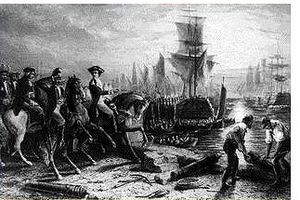
British General William Howe first planned to attack the American position. But a snowstorm stopped his plan. After thinking more, he decided to leave the city instead. On March 17, British troops and Loyalist colonists boarded ships. They sailed for Halifax, Nova Scotia.
Henry Knox became the main artillery officer of the Continental Army. Later, he served as the first United States Secretary of War.
Legacy
The states of New York and Massachusetts placed historical markers along the route Knox was believed to have taken. This was done for the 150th anniversary of the expedition. In 1972, some markers in New York were moved. New information showed how the cannons moved between Albany and the state border. Most of the markers in Massachusetts are along a route that was guessed. This is because there wasn't much information about the roads in Massachusetts at that time.
Fort Knox, an Army base in Kentucky, is famous for holding the United States Bullion Depository. It was named after Henry Knox.
|
See also
 In Spanish: Noble tren de artillería para niños
In Spanish: Noble tren de artillería para niños


